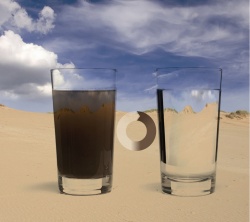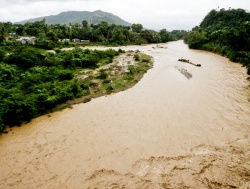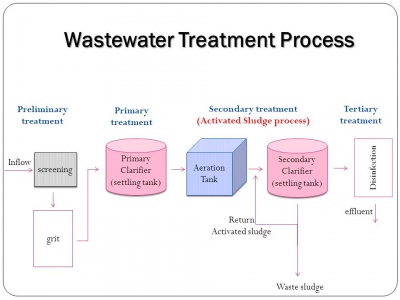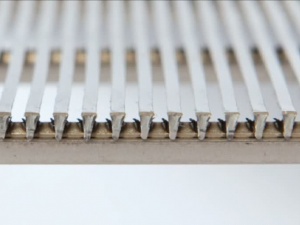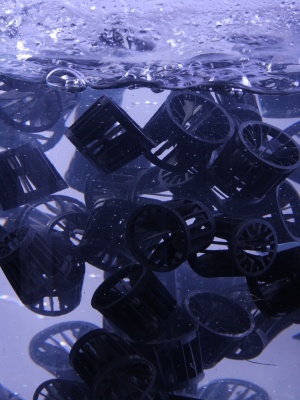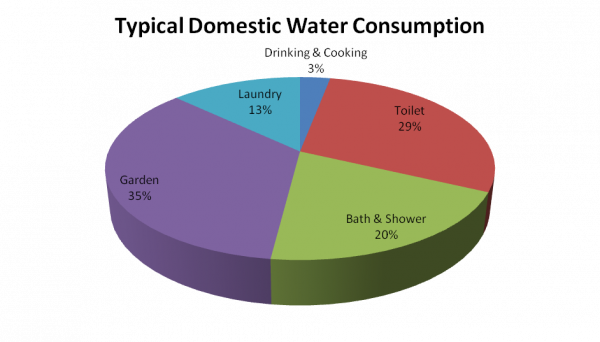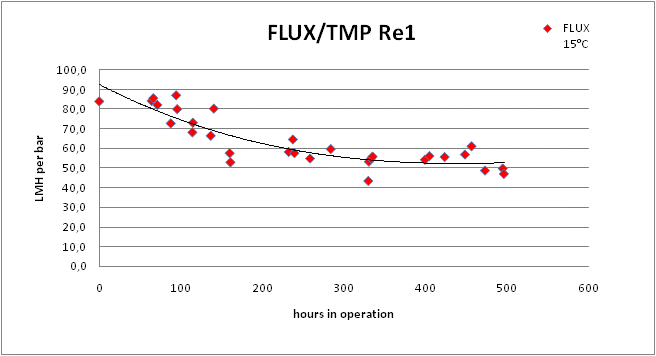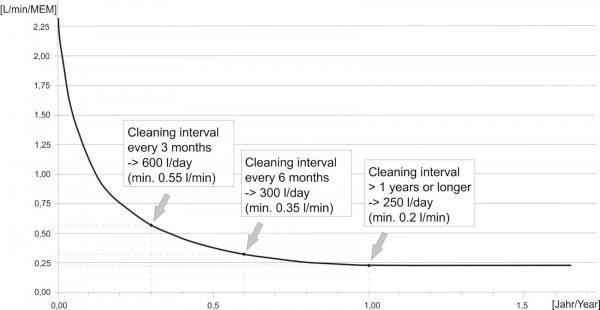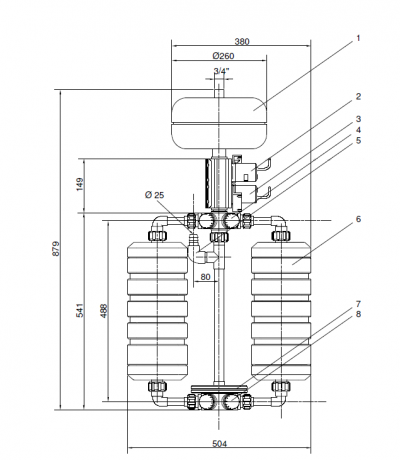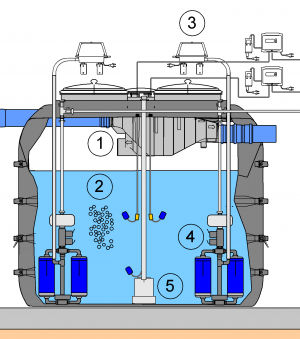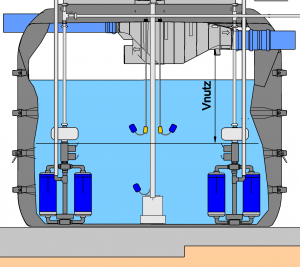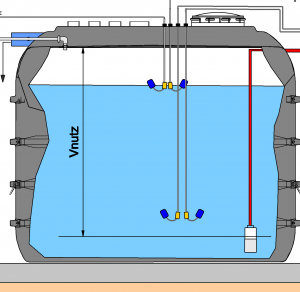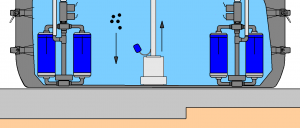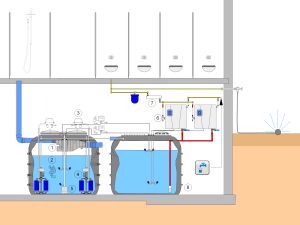Water treatment and greywater recycling
The necessity as well the possibilities to save substantial amounts of municipal drinking water have quickly developed in recent years. In addition to obvious measures such as using low-flow fixtures and simply less water, it goes without saying that treatment of previously used or lightly-contaminated water on-site is also essential.
Water can be obtained from a number of water sources, such as:
- Rainwater
- Greywater from households
- Surface water
- Effluent water from small wastewater treatment systems
- Laundry water
- Groundwater
- etc…
Depending on the level of treatment and source, the treated water can be substituted either as non-potable water for reuse water applications or if it fulfils higher requirements for potable water applications as follows:
- Treatment to non-potable water quality for toilet flushing, irrigation, cleaning purposes, washing machines, cooling water, industrial applications, etc....
- Treatment to potable water quality for showering, washing, drinking, etc....
The areas of application range from single-family dwellings to multiple-family dwellings, sports halls, public buildings, industrial facilities, etc. Therefore water treatment and reuse brings along a bunch of advantages with it:
Advantages for consumers:
- Saving potable water and sewage expenses
- Independence from the water provider
- Consistent supply
- High quality
Advantages for communities
- Reduced costs toward sewer construction, sewer rehabilitation and operating/planned sewage treatment plants
- Reduced costs toward potable water connections, pump stations and operating/planned water treatment plants
- Savings potential in development of new housing areas
- Reduced demand on local water supplies
The huge potential for decentralized water treatment has not yet been exploited. This is partly a result of municipalities requiring connection to the main water supply in order to cover costs. But, by incentivizing decentralized systems, municipalities could also save a lot of costs while creating a thriving business market.
The other hindrance till now was the availability of technology for decentralized water treatment. In the last few years this technology has matured and is now reliable, economical and safe. These factors mean decentralized water treatment should become more common in a variety of applications based on regional needs.
Fundamentals of water quality
Water quality parameters
There are a variety of substances of concern when dealing with untreated water. Different uses including non-potable and drinking water follow different regulations regarding the same or additional water quality parameters. In the following section the most important parameters are described including; COB, BOB5, TOC, conductivity, turbidity, DO, pH and heavy metal concentration.
Hygiene indicators
Hygiene indicators are bacteria, viruses and protozoa.
What these organisms describe and their measurement are very different in water quality terms. This fact is based on the detection methods that were and are applied in different countries and laboratories. An example is that today in the EU bathing water quality is determined by measuring intestinal Enterococci and E. coli present in the water. There is no one organism that can describe and indicate the complete water quality in reference to the regulations.
The following requirements are stated for organisms to be considered hygiene indicators <ref name="isa">ISA - Institut für Siedlungswasserwirtschaft der RWTH Aachen</ref>:
- They should be part of the normal gut microbiota in healthy people (ideally, they should only be present in the human gastrointestinal tract).
- They should only be present when it is likely that pathogens of faecal origin are present.
- They should be present in larger numbers than the pathogens indicated by them.
- They should also grow outside the digestive tract and be more resistant than pathogenic microorganisms (pathogens).
- They should be more resistant than pathogens under natural conditions as well as after water treatment and survive in greater numbers.
- They should be easily isolated, identified and counted.
- They should themselves not cause a disease.
- Their number should be in relation to the quantity of pathogenic microorganisms.
Quality of potential source waters
- Laundry water
- Surface water must be individually examined.
- Groundwater unless in areas of agricultural usage, usually has a very low BOD5, but may contain dissolved metals. Must be individually examined.
- Rainwater, even after coming off the roof, generally has little to no BOD5 and no anthropogenic or other substances of concern.
Water quality requirements
Non-potable systems
In order for water treatment systems to be accepted both by end-consumers, as well as communities and countries, non-potable treated water must fulfill the highest minimum standards of water quality and present no health hazards to the user or general public.
Requirements from market arranged according priority:
- No particulates and good aesthetics (protection of pipework, no odour, low turbidity (clarity))
- DIN 19650 quality requirements for irrigation water
- Low bacterial contamination, corresponding to the EU bathing water guidelines
- USA, UK (BSRIA) non-detectable coliform level
- Multi-barrier approach: Filtration followed by additional disinfection (USA, CA and other countries)
Orienteering oneself around organic contamination and total suspended solids (TSS) the highest worldwide standards prescribe the following water quality parameters for treated non-potable water:
| Parameter | Unit | Limit value |
|---|---|---|
| TSS | mg/L | 10 |
| Escherichia Coli | 1/100 mL | Non-detectable |
| Total coliform bacteria | 1/100 mL | Non-detectable |
In Canada, the USA and Japan a minimum chlorine residual or equivalent disinfection is required when treating for non-potable uses (≥ 0.5 mg/L). Below are some of the different regulations and their requirements from around the world.
Overview of worldwide parameters for non-potable water quality:
| Country | EU | DE | UK | CA | USA | AU |
|---|---|---|---|---|---|---|
| Standard | Bathing water quality Directive 2006/7/EC [1] | DWA-M 277 Recommendations for construction of systems for handling and usage of greywater and greywater partial flows [2] | Greywater systems – BS 8525-1:2010 for spray applications [3] | Canadian Guidelines for Domestic Reclaimed Water for Use in Toilet and Urinal Flushing [4] | NSF/ANSI 350 – 2014 Onsite Residential and Commercial Water Reuse Treatment Systems [5] | Class A reclaimed water quality objectives (EPA Victoria) [6] |
| BOD5 (mg/L) | < 5 | Median 10 Maximum 20 |
Median 10 Maximum 25 |
< 10 | ||
| TSS (mg/L) | Median ≤ 10 Maximum ≤ 20 |
Median 10 Maximum 30 |
< 5 | |||
| PH | 6.5 - 9.5 | 5 - 9.5 | 6.0 - 9.0 | 6 - 9 | ||
| UV-Transmission | > 60 % | |||||
| Turbidity (NTU) | < 2 | < 10 | Median 2 Maximum 5 |
Median 2 Maximum 5 |
< 2 | |
| Colour | Zu messen | |||||
| Odour | Non-offensive | |||||
| Oily film and foam | Non-detectable | |||||
| Dissolved oxygen %O2 | > 50 | |||||
| Residual chlorine (mg/L) | < 2.0 | ≥ 0.5 | ≥ 0.5 - ≥ 2.5 (or equivalent disinfection) |
1 (or equivalent disinfection) | ||
| Residual bromine (mg/L) | 0.0 | |||||
| Sodium adsorption ratio (SAR) | Measured and reported only | |||||
| Total coliforms | < 10,000/100 mL | 10 | Median non-detectable Maximum 200 cfu/100 mL |
|||
| E.coli | 500-1000 cfu/100 mL (Inland waters) 250-500 cfu/100 mL (Coastal and transistional waters) |
< 1,000/100 mL | Non-detectable | Median non-detectable Maximum 200 cfu/100 mL |
Median 2.2/100 mL Maximum 200/100 mL |
< 10/100 mL |
| Legionalla pneumophila | 10/100 mL | |||||
| Intestinal enterrococci | 200-400 cfu/100 mL (Inland waters) 100-200 cfu/100 mL (Coastal and transistional waters) |
Non-detectable | ||||
| Pseudomonas aeruginosa | < 100/100 mL | |||||
| Helminths | < 1 helminth/L | |||||
| Protozoa | < 1 protozoa/50 litres | |||||
| Virus | < 1 virus/50 litres |
Potable water systems
If non-potable water is to be further treated for potable water quality, then the requirements of drinking water regulations of the respective country must be followed. A sample of the parameters to be investigated for the Drinking Water Ordinance 2001 (amendment of Nov. 2011) in Germany is listed in the following overview. <ref name="Gesetz">http://www.gesetze-im-internet.de/trinkwv_2001/index.html</ref>
Part I: General requirements of drinking water
Attachment 1 (for § 5 paragraph 2 and 3) Microbiological requirements
| Serial No. | Parameter | Limit value |
|---|---|---|
| 1 | Escherichia coli (E. coli) | 0/100 mL |
| 2 | Enterococci | 0/100 mL |
Attachment 2 (for § 6 paragraph 2) Chemical requirements
Part I: Chemical parameters, whose concentration will not increase within the distribution network of the connected drinking water installation.
| Serial No. | Parameter | Limit value mg/L |
|---|---|---|
| 1 | Acrylamide | 0.00010 |
| 2 | Benzene | 0.0010 |
| 3 | Boron | 1.0 |
| 4 | Bromate | 0.010 |
| 5 | Chromium | 0.050 |
| 6 | Cyanide | 0.050 |
| 7 | 1,2-Dichlorethane | 0.0030 |
| 8 | Fluoride | 1.5 |
| 9 | Nitrate | 50 |
| 10 | Pesticide and biocide products | 0.00010 |
| 11 | Combined pesticide and biocide products | 0.00050 |
| 12 | Mercury | 0.0010 |
| 13 | Selenium | 0.010 |
| 14 | Tetrachlorethene und Trichlorethene | 0.010 |
| 15 | Uranium | 0.010 |
Part II: Chemical parameters, whose concentration can increase within the distribution network of the connected drinking water installation.
| Serial No. | Parameter | Limit value mg/L |
|---|---|---|
| 1 | Antimony | 0.0050 |
| 2 | Arsenic | 0.010 |
| 3 | Benzo(a)pyrene | 0.000010 |
| 4 | Lead | 0.010 |
| 5 | Cadmium | 0.0030 |
| 6 | Epichlorhydrine | 0.00010 |
| 7 | Copper | 2.0 |
| 8 | Nickel | 0.020 |
| 9 | Nitrite | 0.50 |
| 10 | Polycyclic aromatic hydrocarbons | 0.00010 |
| 11 | Trihalogenmethanes | 0.050 |
| 12 | Vinylchloride | 0.00050 |
Attachment 3 (for § 7 Drinking Water Ordinance + amendment of Nov. 2011) Indicator parameters
Part I: General indicator parameters
| Serial No. | Parameter | Unit | Limit value |
|---|---|---|---|
| 1 | Aluminium | mg/L | 0.200 |
| 2 | Ammonium | mg/L | 0.50 |
| 3 | Chloride | mg/L | 250 |
| 4 | Clostridium perfringens (including spores) | number/100 mL | 0 |
| 5 | Coliform bacteria | number/100 mL | 0 |
| 6 | Iron | mg/L | 0.200 |
| 7 | Colour (Spectral absorption coefficient Hg 436 nm) | 1/m | 0.5 |
| 8 | Odour | TON | 3 at 25°C (analysis according to DIN EN 1622) |
| 9 | Taste | - | Acceptable for the consumer and without special modifications |
| 10 | Coliform count at 22 °C | - | Without special modifications |
| 11 | Coliform count at 36 °C | - | Without special modifications |
| 12 | Electrical conductivity | µS/cm | 2790 at 25°C |
| 13 | Manganese | mg/L | 0.050 |
| 14 | Sodium | mg/L | 200 |
| 15 | Total organic carbon (TOC) | Without special modifications | |
| 16 | Oxidation potential | mg/L O2 | 5.0 |
| 17 | Sulphate | mg/L | 250 |
| 18 | Turbidity | NTU | 1.0 |
| 19 | Acidity | pH | ≥ 6.5 und ≤ 9.5 |
| 20 | Hardness | mg/L CaCO3 | 5 |
| 21 | Tritium | Bq/L | 100 |
| 22 | Totale indicative dose | mSv/year | 0.1 |
Treatment technology
There are a large number of treatment options for water treatment.
For water treatment and particularly applications of reuse water there are three general treatment steps: primary or mechanical/physical pre-treatment, secondary or biological treatment and tertiary disinfection. A fourth stage can also be introduced in the most advanced water treatment system, quaternary or advanced oxidation technologies.
Primary physical treatment
Primary treatment is responsible for removing larger particles from the influent water streams. This can be done in a variety of different ways, see Treatment technology. In general the process begins by filtering large debris through progressively finer bar screens which is then collected and disposed of.
Other primary treatment includes grit, particle and scum removal chambers and clarifiers. These can be combined or separate depending on the design of the treatment plant. The goal in these chambers is to remove both large heavy particles and floating scum which cannot be treated easily in the following stages.
Sedimentation systems provide a large volume that reduces flow so particles can sink and be collected and disposed of. Floating scum is removed by skimmers.
Secondary biological treatment
Water after primary treatment can still be rich in biologically degradable contaminants (BOD). This is actually food for microorganisms and by suppling oxygen to the water, the organisms are encouraged to grow and multiply, consuming the contaminants in an aerobic process.
A kg of BOD needs approximately 1.2 kg of Oxygen to be broken down by the microorganisms in the secondary treatment stage. By knowing the BOD content, flow rate, temperature and dimensions of the tank, engineers can determine exactly how much Oxygen to add through aeration.
Since pure air contains a variety of gases wherein Oxygen is only a portion, ca. 21%, much more air must be provided to a system in order to achieve the necessary conversion of BOD. Diffusors introduce Oxygen from the bottom of the tank by bubbles.
The efficiency of the treatment system depends on the ability of the organisms to reach the food and oxygen. This means that a large surface area for the bacteria growth versus volume is needed.
A particularly efficient design for this required large surface area versus volume is the Moving-bed Biological Reactor (MBBR).
In an AQUALOOP moving bed for example a surface area to volume ratio of 320 m²/m³ is reached.
Tertiary disinfection
Stricter environmental regulations increasingly call for further wastewater treatment measures before discharge into the environment is allowed (surface water or infiltration).
Microfiltration or even better ultrafiltration provides a purely mechanical form of disinfection without producing chemical by-products as with Chlorine disinfection. This filtration is usually provided by flat or hollow-fibre membranes with pore sizes down to 0,02 µm.
The microscopic size of the pores within the filter membrane withholds bacteria and viruses from passing through. The fibres are cleaned by a backwash process and by air bubbles passing over the membrane surface.
Tab.: Pore sizes for different levels of filtration <ref name="TU">TU Berlin, GW Recycling Vortrag 24.2.2004</ref>
| Type | Sizes [µm] |
Filterable |
|---|---|---|
| Filtration | 10 - 100 | Yeast cells |
| Microfiltration | 10-1 - 10 | Bacteria |
| Ultrafiltration | 10-2 - 10-1 | Viruses |
| Nanofiltration | 10-2 - 10-3 | Partial dissolved salts |
| Reverse Osmosis | 10-4 - 10-3 | Dissolved salts |
For treatment of non-potable water and sterilization, micro or ultrafiltration is necessary. Dissolved substances however cannot be filtered out.
UV Disinfection
Especially in cases of reuse of greywater or wastewater some treatment standards require further disinfection of the already treated and stored water in order to eliminate the risk of re-contamination. UV disinfection is designed for this purpose when installed behind the pressure increasing system.
Quaternary treatment
Also known as Advanced Oxidation Processes or AOP,this treatment step is only included in the most advanced water treatment plants. Advanced oxidation processes, in a broad sense, are a set of chemical treatment procedures designed to remove organic (and sometimes inorganic) materials in water and wastewater by oxidation through reactions with hydroxyl radicals (OH).
Planning and dimensioning
Simple dimensioning of various system applications can be found here.
Below is an example of how a greywater recycling system is dimensioned and the most important considerations involved.
Input values for dimensioning
Values for dimensioning can vary greatly between systems, regions and countries and depend heavily on different consumption patterns. Below are descriptions of each dimensioning step as well as example calculations in which specific values can be substituted.
Water supply
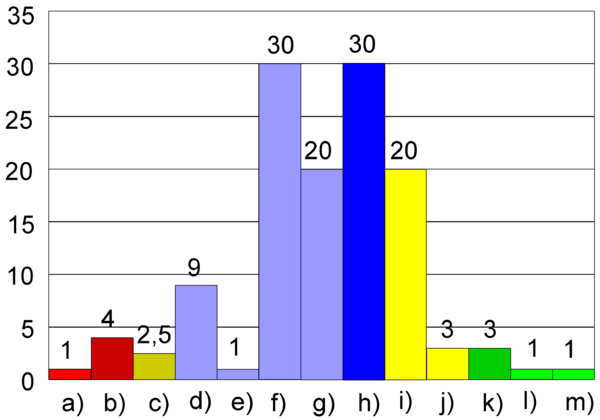
| a. Drinking | e. Teeth brushing | i. Washing machines | m. Garden |
| b. Cooking | f. Bathing- 2x per week | j. Cleaning | |
| c. Dishwasher | g. Showering - 2x per week | k. Car washing | |
| d. Washing | h. Toilet flushing | l. Indoor plants |
In general, the average daily water usage can be found and calculated from the different streams i.e. Bath & Shower, using the above diagram. These can also be measured directly on-site or taken from national associations and standards as seen below for Germany and Australia.
The values can be looked at in one of two ways: as the daily water needs and the supply of water for reuse purposes.
| Supply/person/day | Germany (fbr) | Australia (NSW) |
| Shower, bath and sinks | 40 L | 66 L |
| Washing machine | 13 L | 47 L |
| Total supply | 53 L | 113 L |
Water needs
| Needs/person/day | Germany (fbr) | Australia (NSW) |
| Toilet | 25 L(average) | 14,4 L |
| Washing machine | 13 L | 47 L |
| Cleaning | 5 L | - |
| Irrigation | 5 L | 35 L |
| Total needs | 48 L | 96,4 L |
In the example shown, the existing greywater sources equalling 52 L cover the daily demand of 48 L. For larger demands other sources such as rainwater can cover the extra demand.
Reuse water parameters
The quality of water to be recycled depends heavily on its source. As an example of greywater, see below for some typical ranges that are used in dimensioning of systems.
COD - 250-430 mg/L Germany (fbr)
BOD - 125-250 mg/L Germany (fbr) Average = 187.5 mg/L
N - 0.7-48 mg/L Australia (NSW) (Greywater from washing machine)
Reuse water pipework dimensioning
Information in this section is based on the German standard DIN 1986-100:2016-12: Contaminated water discharge from collection pipework within buildings. This is an example only and the necessary regional or national standards should be consulted during dimensioning of your reuse water system.
Table: Discharge ability of drainage pipework with a fill volume of h/d = 0.5 from Tab. A.3 from DIN 1986 with a minimum grade of 1.00 cm/m.
| DN | di, min mm |
Qww, max L/s |
|---|---|---|
| 100 | 96 | 2.5 |
| 150 | 146 | 7.7 |
| 200 | 184 | 14.2 |
| 300 | 290 | 47.4 |
Determination of discharge ability:
According to
| Qww | Discharge ability in litres per second, (L/s) |
| K | Discharge ratio |
| ∑DU | Sum of discharge values |
Table: Discharge ratios (K)
| Building type and usage | K |
|---|---|
| Unregular usage e.g. in apartment buildings, old-age and boarding homes, offices | 0.5 |
| Regular usage e.g. hospitals, schools, restaurants, hotels | 0.7 |
| Frequent usage e.g. in public toilets, and/or showers | 1.0 |
Table: Connection and size values from ventilated and unventilated single connection piping taken from Tab. A.6 of DIN 1986.
| Drainage object | Connection value DU L/s |
Single connection piping |
|---|---|---|
| Sinks | 0.5 | DN40 |
| Showers | 0.8 | DN50 |
| Baths | 0.8 | DN50 |
| Washing machines | 1.5 | DN 56/60 |
Example:
Table: Example calculation from an apartment building
| Drainage object | Total connection value DU
L/s |
|---|---|
| 20 x Showers | 16.0 |
| 20 x Sinks | 10.0 |
| 20 x Washing machines | 30.0 |
| Total | 56.0 |
=> From Tab. A.3 a DN150 collection connection would be adequate.
Packing bed dimensioning
While the design for activated sludge process relies on the sludge load (kg BOD/kg TS/day), a maximum surface loading is generally determined for packing bed processes. This is calculated from the amount of pollutants entering the system per day (g BOD or COD), the area available on lava rocks, plastic growth carriers or equivalent and is given in kg BOD or COD/m²/day.<ref name="isa" />
In small wastewater treatment systems, a surface load of <0.004 kg BOD5/m²/day should be maintained to ensure proper operation with a factor of safety. Based on this and since the COD content is on average twice the BOD content, the COD surface loading can be assumed to be 0.008 kg COD/m²/day.
In addition to the oxygen consumption for BOD degradation, the oxidation of nitrogen from ammonium NH4 to nitrate NO3 is to be considered. This increases the required amount of air depending on the nitrogen content in the reuse water (approx. 10 mg N/L with greywater). With greywater this leads to three times the amount of oxygen required, approx. 30 mg/L. Normally the water is not continuously distributed throughout the day in reuse systems Therefore it must be ensured that the packing bed receives sufficient time (> 2 h) after loading to reduce pollution. During this period, the clean water should not be drawn from discontinuous system, because otherwise it may lead to increased COD/BOD5.
MBBR growth carriers
One type of biological water treatment is called MBBR (Moving-bed biological reactor). The so-called moving-bed consists of numerous growth carriers (growth bodies) within the treatment reactor, which have a high surface-to-volume ratio. The required quantity of growth bodies can be determined from the permissible surface load of 0.004 kg BOD/m²/day which is based on the inlet flow rate and organic loading. Example: 300 L/day greywater system for a single-family home As stated previously the average BOD concentration in greywater is on average 187.5 mg/L.
By dividing by the maximum surface load allowed, determine the surface area needed,
Now take the surface area/volume ratio from the growth carrier manufacturer, in this case 320 m²/m³ and divide the required surface area,
=> For this single-family home system 44 L of growth carriers are needed.
Determining the oxygen requirement
In the bioreactor the bacteria must be supplied with oxygen and nutrients. The nutrients are the BOD content of the source water. The average BOD of greywater systems is approximately 187 mg/L. A specific amount of air is required for treating this.
Some of the parameters influencing the air requirement are:
- Temperature
- Chemical inlet parameters (see greywater inflow data)
- Aeration depth
- Diffusor area
For simplicity, an oxygen content of 23 %wt. can be assumed.
Experience has shown that approximately 1.2 kg of oxygen are required for the conversion of 1 kg of BOD.
The efficiency of the oxygen exchange into the water depends on the bubble size and the duration of the bubbles in the water. Coarse bubble diffusors generally have an oxygen exchange efficiency of 1% per meter due to their low surface area to volume ratio. Fine bubble diffusors generally have an efficiency of 5% per meter. The deeper the diffusors are installed in the water, the more oxygen is exchanged into the water.
If an intermittent aeration cycle is used then the blower size may change.
Example: Aeration of a 6-person greywater system with coarse bubble diffuser
=> The quantity of air 10.2 L/min is for constant blower operation.
Table: Dry air requirement for greywater systems with a coarse bubble diffuser and an aeration depth of 2 m
| Air density | 1.293 | kg/m³ | Supply | 60 | l/person/day | |||
| O2 | 23% | Molar mass fraction | BOD content | 187.5 | mg/L | |||
| O2 in air |
0.29739 | kg/m³ | O2 need | 1.2 | kgO2/kgBOD | |||
| GW inlet | BOD inlet | O2 requirement | with 1% efficiency |
Air demand | ||||
| PE | L/day | kgBOD/day | mg BOD/min | mgO2/min | m³Air/min | LAir/min | LAir/min | m³/day |
| 6 | 360 | 0.0675 | 46.9 | 56.3 | 0.000203 | 0.203 | 10.2 | 14.7 |
Dimensioning blower
With AQUALOOP technology, air is supplied through the blower which performs several functions at the same time:
- Cleaning of the membrane fibres by creating turbulence through the fibres (> 30 litres/min/membrane)
- Cleaning the fluidized-bed growth bodies (> 30 litres/min/30 litres of growth bodies)
- Introduction of oxygen (see Determining the oxygen requirement)
Example: Single-family house with 6 inhabitants, coarse-pore diffusor
Blower cycle: 5 minutes aeration, 10 minutes pause
Blower operation: 20 minutes/hour or 8 hours/day
The system must therefore provide the same amount of air as a continuous operating system but in 1/3 of the operation time.
=> A blower with a flow rate of > 30.6 L/min is needed.
For larger systems, that require more oxygen introduction, a fine-pore diffusor should be installed.
Example: Aeration with fine-pore diffusor at 2 m depth for 20,000 L greywater / day
=> A blower with a flow rate of > 112.9 L/min is needed.
Due the efficiency difference between coarse-pore and fine-pore diffusors, in particular for larger systems, continuous fine.pore diffusors should be installed to have the most efficient operation as possible.
Membrane technology
Membrane technology has been established in recent years as a promising method to deliver hygienically pure water. Membrane filtration will, as with a sieve, be dependent on the membrane pores for filtering out fine particles down to dissolved substances as well as bacteria and viruses.
The often stated disadvantages of membrane filtration
- higher energy requirement due to required pressure differential
- membrane fouling increases the required pressure differential
- fats and oils block the membrane
- limited suction and backwash pressure with sheet membranes
- higher maintenance effort due to specialized chemical cleaning performed by specialists
- low membrane lifetime
- higher price of the membrane
can be resolved wherever possible by optimization of the pre-filtration, biological degradation and with new membrane technology so that today membrane technology can be successfully introduced into an expanded application range.
Pore sizes, pressure differential
| Size [µm] | required pressure differential [bar] |
Filterable | |
|---|---|---|---|
| Filtration | 10 – 100 | 10-1 – 1 | Yeast |
| Microfiltration | 10-1 – 10 | ca. 1 | Bacteria |
| Ultrafiltration | 10-2 – 10-1 | ca. 5 | Viruses |
| Nanofiltration | 10-3 – 10-2 | 10 | Partial salts |
| Reverse Osmosis | 10-4 – 10-3 | 100 | Salts |
<ref name="TU Berlin">TU Berlin, GW Recycling Vortrag 24.2.2004</ref>
Micro and ultrafiltration are designed for non-potable water treatment and disinfection. Dissolved substance however cannot be filtered out.
Membranes for ultra and microfiltration
For cleaning special organic fibres are deployed in ultra and microfiltration for water and wastewater treatment. The basic principal of this filtration is the use of porous, organic hollow-fibre membranes with microscopic pores as a filter medium. The fibres have an outside diameter of less than 1 mm. In order to maintain an adequate surface area and a constant flow, hundreds of fibres are bundled together and wound around a module. Regular chemical cleaning can be eliminated. Advantages oft he new membranes are:
- The membrane fibres are permanently hydrophilic so they function immediately when immersed in water, drying does not damage the membrane
- Backwashable with up to 3 bar
- Special additives in the PE membrane prevent growth of microorganisms, suppression of 99.97% according to the Japanese standard JIS Z 2801
- The membrane is stable against acidic, alkaline as well as chlorine-based cleaning solutions
Membrane flow rate, flux-stabilization curve without chemical cleaning
Over time, the flow through a membrane decreases, approaching a so-called stabilization flux. This is the flow that remains constant for a very long time without further cleaning.
- A biolayer forms on the membrane fibres
- Depending on the water quality and cleaning mode with backwash and aeration, the membrane will stabilize to a constant flow rate
- The stabilization value is used for flow rate simulations. In the example, the stabilization value is approximately 50 L/m²/hr/bar. The stabilization value is dependent on operation settings, flow rate, wastewater quality, temperature and pre-treatment.
Flow rate and membrane life with chemical cleaning
The AQUALOOP membrane can be loaded with 1 Mio. ppm free chlorine without limitation on its 10-year lifespan. With the recommended cleaning concentration of 0.25% (= 2500 ppm) approx. 400 chemical cleanings can be conducted without limiting the lifespan. To calculate a reduced lifespan due to chlorine cleaning, the following formula can be used:
| L [years]: | lifespan in years (maximum 10 years) |
| Chlorinetotal: [ppm] | 1 Mio. (total allowable load with free chlorine) |
| Chlorineconc: [ppm] | cleaning concentration (max. 0.5% = 5,000 ppm) |
| N [-] | number of cleanings per month |
Example:
Cleaning 4 times per month (N = 4) with a 0.25% cleaning solution (chlorineconc = 2500 ppm):
The membrane lifespan therefore amounts to 8.3 years.
Membrane station
In the application example shown the membranes are installed on a type of station. The integrated suction pump draws the water uniformly through the membrane and supplies it to a treated water tank through a filtrate hose. To guarantee over time a high flow rate the membrane is periodically flushed with an integrated backwash pump. The required volume for backwash water is taken by the system out of the backwash tank which is found above the pumps. Furthermore the membrane will be periodically blown clean with air directed through the fibres to remove deposits. To this end the membrane station is connected to a blower through a hose attachment. The air is uniformly distributed through a connection manifold with symmetric connections and supplies simultaneously the bioreactor with oxygen. For larger water treatment systems multiple membrane stations can be connected in parallel.
Since the work is over a very large membrane surface area the pressure differential and required energy needs for filtration are low. Demonstration systems have shown an energy requirement of less than 2.5 kWh/m³.
Membrane process advantages
- Quality criteria for filtrate (TSS, turbidity, coliforms) is easily achieved
- No or little sludge yield on the treated water side
- Stable operation, not susceptible to load fluctuations
- Compact system sizes, smaller bioreactor required
- Less operating effort
- The biological pre-treatment cleans the water so the membrane must filter only the remaining sludge so that odour-forming compounds are also removed
Tank Dimensioning
In a greywater recycling system two types of tanks are distinguished:
- Bioreactor
- Treated water storage
The size of the bioreactor depends on the degree of water contamination, the treatment volume and the flow through the filter membranes. The size of the treated water storage depends on the daily demands of the user as well as the flow through the membrane filters.
Bioreactor
A bioreactor is only needed for reuse system with > 5 mgBOD/L such as with greywater or wastewater. Below this amount aeration is not required for treatment but the tank dimensioning principals are the same.
The bioreactor usually contains the aeration and growth carriers for water treatment as well as biological sludge removal as well.
Example: Greywater recycling system in a 112-person apartment building in Europe
The so-called "working volume" should be > 50% of the daily need.
In the example system the minimum water level is set at 700 mm so that the membrane filters are always submerged in the water.
Using a tank with the following dimensions, the working volume for the example system can be calculated:
Height: 2.1 m
Overflow height: 1.55 m
Length: 2.39 m
Width: 1.35 m
Working height = 1.55 m - 0,7 m = 0.85 mm Working volume = 2.39 m x 1.35 x 0.85 = 2.74 m³
=> The tank has a working volume greater than the 50% daily needs of the users.
Treated water storage
A treated water tank depends on the daily water needs of the building and should provide for 50% of the daily needs. The working volume of the treated water storage is the volume between the emergency overflow and the suction inlet.
Degree of usage
The degree of usage of a water treatment system is the ratio of need versus yield.
Sample calculation for a greywater recycling system:
Building: Single-family home with 4 inhabitants
Usage: Toilet, washing machine, cleaning and irrigation, see 3.1.2 water needs for Germany
=> The greywater yield in this example is slightly higher than the demand. This is optimal in order to compensate for daily fluctuations (see table "Daily fluctuations of greywater daily production percentages in an apartment building as an example").
If the yield is significantly higher than the demand then, for example, the connection to the washing machine discharge can be disconnected. The discharge water from the washing machine is more polluted and this reduces the maintenance intervals of the reuse systems.
If the yield is lower than the demand, then it should be checked whether the discharge from a wastewater treatment system or rainwater harvesting can be connected. With new technologies, such as reverse osmosis or advanced oxidation, multiple re-processing of the reuse water is now a possibility.
When dimensioning a reuse water system it is also necessary to take in account when the water volumes are produced and consumed within a day. Depending on the building type, large fluctuations can occur within the day. The following table illustrates this
Table: Daily fluctuations of greywater daily production percentages in an apartment building as an example
| Time interval | Percentage proportion of daily volume % |
|---|---|
| 6 hrs to 9 hrs | 30 |
| 9 hrs to 12 hrs | 15 |
| 12 hrs to 18 hrs | 0 |
| 18 hrs to 20 hrs | 40 |
| 20 hrs to 23 hrs | 15 |
| 23 hrs to 6 hrs | 0 |
Dimensioning of sludge pump
Sludge pumps should be positioned so that no „dead zones“ exist. Dead zones are areas with little aeration or mixing of the water.
Installation of water treatment systems
Connection of water treatment system to pipework
Many homes and buildings provide the option to install water treatment systems so that the collection of the water is achieved simply by gravity. The size of the pipe needed can be calculated as under section 3.1. These gravity systems must simply be installed below the outlet of the collection points like showers and can be in basements, underground, indoor/outdoor, etc.
Many homes and buildings are also single-story structures and the location may prevent installation of the water treatment systems below the outlet collection level. In this case, a lift pump is needed to raise the water to the level of inlet to the water treatment system.
Quality requirements at pipeline system
In water treatment systems, piping and hoses are required for the non-potable water as well as the aeration (blowers) supply. Many regulations governing reuse and non-potable water require that the piping supplying this water be indicated as such using either colours (purple in the case of Australia and California) or labels or both.
- Experience has shown that blower hoses, suction hoses for distribution pumps and filtrate hoses are best installed using EPDM material piping.
- The non-potable or reuse piping from the distribution pumps to the connected fixtures is recommended as pressure-resistant plastic or if desired, copper piping.
- Do not use copper piping in the storage tank because it oxidizes even at low concentrations of hydrogen sulphide (foul odour) in combination with humidity.
- All PVC hoses, as well as those chemically resistant, are eventually bleached due to contact with water. The softening agents serve as an ideal breeding ground for bacteria. Odours are also possible.
Blower piping
The loss of pressure by friction is to be considered with a long blower piping. This is primarily dependent on the pipe cross-section, wall roughness and the flow rate of supply air.
Dimensioning is done based on the pump curve of the installed blower. The maximum pressure at the dimensioning point is calculated by:
According to:
Total required pressure at maximum
Water level above air inlet
Pressure losses in piping
| Blower type | pges,max [mbar] | pW,max [mbar] | pV, max [mbar] | ½“- max. pipe length [m] | 1“- max. pipe length [m] |
|---|---|---|---|---|---|
| AL-BL30 | 130 | 110 | 20 | 66 | -- |
| AL-BL60 | 170 | 150 | 20 | 20 | 500 |
| AL-BL100 | 200 | 180 | 20 | -- | 220 |
| AL-BL120 | 200 | 180 | 20 | -- | 140 |
| AL-BL200 | 200 | 180 | 20 | -- | 70 |
Table: Pipe cross-sections and maximum lengths with AQUALOOP blowers
Ventilation system
The ventilation of sanitary pipes within buildings is governed by DIN EN 12056. The German supplementary standard DIN 1986-100 is used.
AQUALOOP does not require separate ventilation if connected to a ventilated inlet supply pipe. Individual AQUALOOP tanks are connected together above the maximum water level. This does not apply to multiple tanks connected together for either bioreactor or clear water storage volume. Drainage fixtures to AQUALOOP systems are equipped with a siphon when required according to national or regional plumbing standards. If a lift pump after the overflow is to be provided, attention must be paid to the connection in regard to national or regional standards.
Sources
<references />
